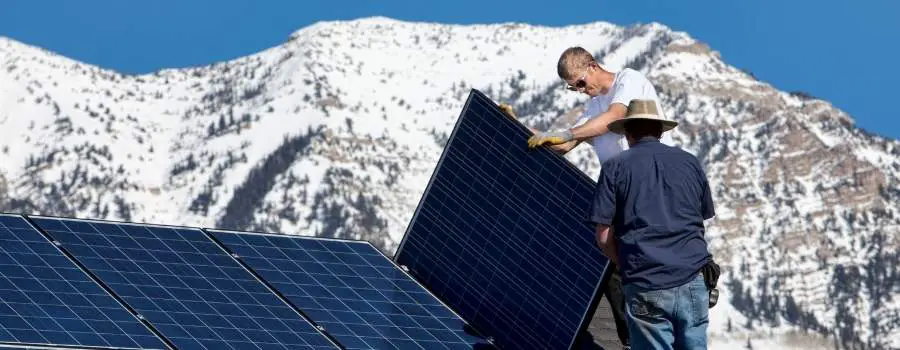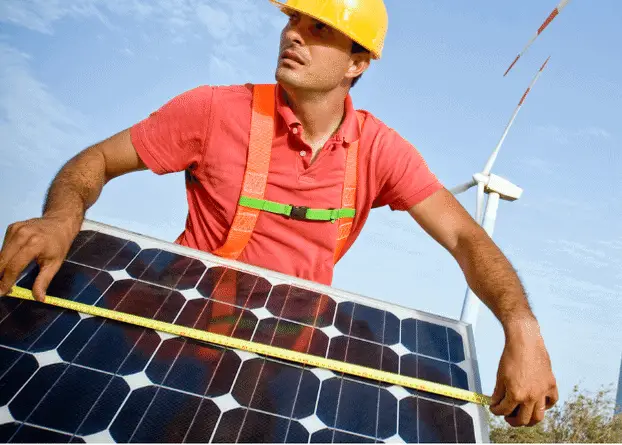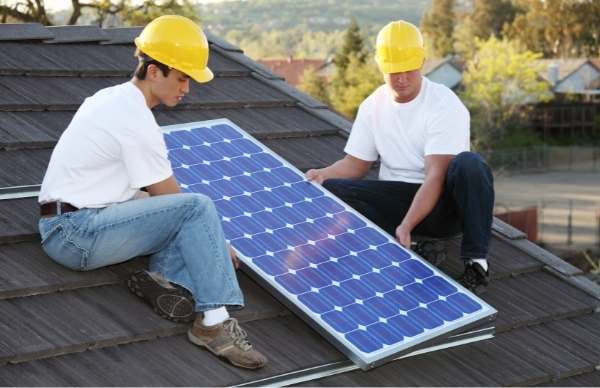
Solar panels have a long life-span, but people don’t usually have them installed at the same time they have their roof replaced or repaired. This means that for the majority of home owners, they will have to remove their solar array when vital roof repairs are needed. You’re already paying for that new roof…how much can you expect to pay to remove your solar panels?
Removal costs for small residential solar systems range from $500-$1,500, while medium to large systems can cost $1,500-$3,000+. Costs cover labor, panel detachment, and hardware dismantling, but usually does not cover re-installation.
That’s the short answer, but there is SO MUCH to be considered when taking on a project like this. Down below I’ve broken down some important considerations home owners will need to know before they get in over their heads!
Average Costs of Solar Panel Removal
When planning for the removal of solar panels, it’s essential to have an understanding of the potential costs involved. Below is a general overview of the average costs associated with solar panel removal, keeping in mind that these figures can fluctuate based on specific circumstances.
Cost Based on System Size and Complexity
- Small-Scale Residential Systems: For smaller residential solar installations, typically comprising a few panels, the average removal cost can range from $500 to $1,500. This cost accounts for the labor involved in safely detaching and lowering the panels, as well as the dismantling of the mounting hardware (1).
- Medium to Large Residential Systems: For more extensive residential systems, which have a larger number of panels or more complex configurations, the removal costs can range from $1,500 to $3,000 or more. The increased cost is primarily due to the additional labor and time required, as well as the potential need for specialized equipment.
- Commercial Systems: For commercial installations, which are often much larger and more complex than residential systems, the costs can start at $4,000 and go upwards, depending heavily on the scale and accessibility of the installation.
Regional Cost Variations
- United States: Within the U.S., the cost can vary by region. Typically, urban areas with a higher cost of living may see higher prices for labor, potentially increasing the overall removal cost. For example, removal costs in states like California and New York might be higher than the national average.
- Europe: In European countries, costs might be comparable to those in the U.S., though they can vary significantly between Eastern and Western Europe due to differences in labor costs and market maturity.
- Australia and Asia: In Australia, the removal costs are generally in line with the higher end of U.S. prices due to the extensive use of solar energy. In parts of Asia, however, the costs might be lower, reflecting the local labor market and economic conditions.
Potential Additional Costs
When removing solar panels from a home, homeowners should be aware of potential additional costs that may arise beyond the basic removal expenses. These costs can significantly affect the overall budget for the project. Here are some key additional costs to consider (2):
Repairing Roof Damage
- Assessment and Repair Costs: During the removal process, there’s a possibility of roof damage, particularly with older roofs or those with fragile materials. Costs can include professional assessment of any damage and subsequent repairs. This could range from minor fixes (like replacing a few roofing tiles) to more extensive repairs if significant damage is uncovered.
- Preventative Measures: In some cases, preventive measures may be needed to reinforce the roof before reinstallation of the panels, adding to the cost.
Temporary Storage of Panels
- Storage Fees: If the solar panels are being removed temporarily (e.g., for roof repairs or renovations), there may be costs associated with storing the panels. The cost will depend on the duration of storage and the facility used, potentially adding hundreds of dollars to the project, especially if climate-controlled storage is required.
Re-installation Costs
- Re-installation Expenses: If the plan involves reinstalling the panels after removal, this will incur additional costs. These expenses can be similar to or even exceed the initial installation costs, depending on the complexity of the re-installation, any updates to the mounting system, and potential modifications to the system.
- System Upgrades: Sometimes, reinstallation is accompanied by system upgrades or efficiency improvements, which, while beneficial in the long term, can increase upfront costs.

Removal Process
Removing solar panels from a home is a complex task that requires meticulous planning and execution. This process involves several steps, each demanding a high level of expertise and safety measures.
Initial Assessment and Planning
- Site Inspection: Before any removal begins, a thorough inspection of the installation site is needed. This step involves assessing the condition of the solar panels, the integrity of the mounting system, and the type of roofing material. Professionals also evaluate the accessibility of the roof and the layout of the solar array to devise a strategic removal plan.
- Safety Protocols: Setting up safety measures includes securing the work area, ensuring that technicians use personal protective equipment (PPE) such as harnesses and helmets, and implementing measures to prevent falling objects.
- System Shutdown: The solar power system must be safely disconnected from the electrical grid to eliminate the risk of electric shock. This involves shutting down the inverter, disconnecting the batteries (if present), and checking that all electrical connections to the solar panels are safely deactivated.
Removal Process
- Dismantling the Mounting System: After the system is electrically isolated, technicians begin to carefully dismantle the mounting hardware. This involves unscrewing the fasteners and brackets that hold the solar panels in place.
- Panel Removal: Each solar panel is gently lifted off the mounting system. This step requires at least two technicians to ensure the panels are handled safely and to prevent any damage. Special attention is given to the wiring connected to the panels to avoid any damage.
- Packing and Transportation: Once removed, the solar panels are packed to prevent any damage during transportation. They are often wrapped in protective materials and placed in a safe, transport-ready position.
Post-Removal
- Roof Inspection and Repair: After the panels are removed, the roof is inspected for any potential damage caused during installation or removal. If any damage is found, it should be repaired promptly to maintain the integrity of the roof.
- Reinstating Roof Integrity: If the mounting system required roof penetration, these holes must be properly sealed to prevent leaks. The sealing process should be compatible with the roofing material to ensure a watertight seal.
- Site Clean-Up: The final step involves cleaning the work area, removing any debris, and leaving the site in a safe and tidy condition.
The Need for Professional Services

Given the complexity and risks involved in the solar panel removal process, removing solar panels really isn’t a DIY task.
Professional solar technicians have the necessary training, experience, and equipment to carry out the job safely and efficiently.
They understand the intricacies of different solar panel systems and are equipped to handle unexpected challenges that may arise during the process.
Professionals will handle the proper removal of the panels and other equipment and they’ll make sure everything is conducted in compliance with industry standards and local regulations.
Factors Influencing the Cost of Removal
Understanding everything that goes into the cost of solar panel removal is important for homeowners to anticipate. Since many will be budgeting for roof repairs or replacement, the cost of panel removal can be quite the sticker shock if you’re not prepared for it.
Size and Number of Panels
- Larger Installations: The size of the solar panel installation is one of the most significant determinants of removal cost. Larger systems with more panels require more labor, time, and often more complex logistics. The process of detaching and safely lowering each panel can be labor-intensive, especially for extensive arrays.
- Panel Dimensions: The physical size of the panels themselves can also affect the cost. Larger, heavier panels might require additional manpower or specialized equipment to handle safely, thereby increasing the cost.
Type of Roofing
- Roof Material: Different roofing materials can complicate the removal process. For instance, tiles or slate roofs are more fragile and require extra care to avoid breakage, whereas metal or composite roofs might present fewer challenges.
- Mounting System Adaptation: The adaptation of the solar panel mounting system to the specific type of roof can also impact the removal cost. Some mounting systems are more intricate and time-consuming to dismantle, especially if they are integrated into the roofing material.
Accessibility
- Roof Accessibility: The ease of access to the roof where the panels are installed plays a crucial role. Roofs that are hard to reach, have steep slopes, or have obstructions such as trees or other structures nearby can make the removal process more challenging and time-consuming.
- Equipment Requirement: Difficult-to-access roofs might require additional safety equipment, scaffolding, or even cranes to remove the panels safely, which can add to the cost.
Condition of the Panels and Mounting System
- Age of the System: The age of the solar panel system can influence removal costs. Older systems might have outdated mounting hardware that is more difficult to dismantle, or the connections may have corroded over time, requiring more delicate handling.
- Wear and Tear: The condition of the panels and the mounting system is also a factor. Panels or mounting systems that have been damaged by weather, animals, or other external factors might need extra care during removal to prevent further damage.
- Potential Repairs: In some cases, the removal process may uncover the need for repairs to the panels or the mounting system before they can be safely detached. This could add unexpected costs to the removal process.
Frequently Asked Questions
Can I remove solar panels myself?
It’s highly recommended to use professional services due to the technical and safety risks involved.
How long does it take to remove solar panels?
Typically, removal takes a few hours to a day, depending on the system’s size and complexity.
Will removing solar panels damage my roof?
If done professionally, the risk of damage is minimal. However, older roofs may have higher risks.
Can removed solar panels be reused?
Yes, panels can often be reused if they’re still in good condition.
Does solar panel removal affect my home’s value?
This depends on market trends and the buyer’s preference for solar energy.
